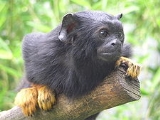
Red-handed Tamarin
Encyclopedia
The red-handed tamarin (Saguinus midas), also known as the golden-handed tamarin or Midas tamarin, is a New World monkey
named for the contrasting reddish-orange hair on their feet and hands. It is native to wooded areas north of the Amazon River
in Brazil
, Guyana
, French Guiana
, Suriname
, and possibly Venezuela
. The population south of the Amazon River lacks the contrasting feet and hands, and is now commonly treated as a separate species, the Black Tamarin
.
They live in cooperative groups of 4 to 15 members with little competition among a group even between breeding males. Only one female among a group will breed during breeding season with the other females suppressing the instinct. The gestation period is 140–170 days and mothers typically give birth to two offspring
Young tamarin
s are cared for primarily by the father and turned over to the mother only to nurse, however the entire group helps with the care of the young.
Defense is a priority in a group, and when one tamarin is threatened the others will rush to its defense. The red-handed tamarin is territorial and can be aggressive, with sharp canines and claws instead of fingernails on all fingers and all but the large toe.
The red-handed tamarin is an exceptional climber and spends most of its time among the vines and branches of the trees. They are quick and agile and are superb jumpers known to jump distances of over 60 feet (18.3 m) from a tree to the ground with no sign of injury.
The tamarin's diet consists of fruit, flowers, insects, frogs, spiders, lizards, and nectar.
The red-handed tamarin's body measures 20.5–28 cm (8.1–11 in); including the tail they measure 31–44 cm (12.2–17.3 ). They weigh 400–550 g (0.88184904873951–1.2 lb). Their life expectancy is approximately 10 years in the wild and 16 years in captivity.
Their natural predators are small cats, birds of prey, and snakes.
New World monkey
New World monkeys are the five families of primates that are found in Central and South America: Callitrichidae, Cebidae, Aotidae, Pitheciidae, and Atelidae. The five families are ranked together as the Platyrrhini parvorder and the Ceboidea superfamily, which are essentially synonymous since...
named for the contrasting reddish-orange hair on their feet and hands. It is native to wooded areas north of the Amazon River
Amazon River
The Amazon of South America is the second longest river in the world and by far the largest by waterflow with an average discharge greater than the next seven largest rivers combined...
in Brazil
Brazil
Brazil , officially the Federative Republic of Brazil , is the largest country in South America. It is the world's fifth largest country, both by geographical area and by population with over 192 million people...
, Guyana
Guyana
Guyana , officially the Co-operative Republic of Guyana, previously the colony of British Guiana, is a sovereign state on the northern coast of South America that is culturally part of the Anglophone Caribbean. Guyana was a former colony of the Dutch and of the British...
, French Guiana
French Guiana
French Guiana is an overseas region of France, consisting of a single overseas department located on the northern Atlantic coast of South America. It has borders with two nations, Brazil to the east and south, and Suriname to the west...
, Suriname
Suriname
Suriname , officially the Republic of Suriname , is a country in northern South America. It borders French Guiana to the east, Guyana to the west, Brazil to the south, and on the north by the Atlantic Ocean. Suriname was a former colony of the British and of the Dutch, and was previously known as...
, and possibly Venezuela
Venezuela
Venezuela , officially called the Bolivarian Republic of Venezuela , is a tropical country on the northern coast of South America. It borders Colombia to the west, Guyana to the east, and Brazil to the south...
. The population south of the Amazon River lacks the contrasting feet and hands, and is now commonly treated as a separate species, the Black Tamarin
Black Tamarin
The black tamarin or black-handed tamarin, is a species of tamarin endemic to Brazil. It has traditionally been treated as a subspecies of the Red-handed Tamarin, but lacks the contrasting reddish-orange feet and hands of that species....
.
They live in cooperative groups of 4 to 15 members with little competition among a group even between breeding males. Only one female among a group will breed during breeding season with the other females suppressing the instinct. The gestation period is 140–170 days and mothers typically give birth to two offspring
Young tamarin
Tamarin
The tamarins are squirrel-sized New World monkeys from the family Callitrichidae in the genus Saguinus. They are closely related to the lion tamarins in the genus Leontopithecus.- Range :...
s are cared for primarily by the father and turned over to the mother only to nurse, however the entire group helps with the care of the young.
Defense is a priority in a group, and when one tamarin is threatened the others will rush to its defense. The red-handed tamarin is territorial and can be aggressive, with sharp canines and claws instead of fingernails on all fingers and all but the large toe.
The red-handed tamarin is an exceptional climber and spends most of its time among the vines and branches of the trees. They are quick and agile and are superb jumpers known to jump distances of over 60 feet (18.3 m) from a tree to the ground with no sign of injury.
The tamarin's diet consists of fruit, flowers, insects, frogs, spiders, lizards, and nectar.
The red-handed tamarin's body measures 20.5–28 cm (8.1–11 in); including the tail they measure 31–44 cm (12.2–17.3 ). They weigh 400–550 g (0.88184904873951–1.2 lb). Their life expectancy is approximately 10 years in the wild and 16 years in captivity.
Their natural predators are small cats, birds of prey, and snakes.

